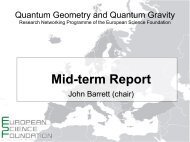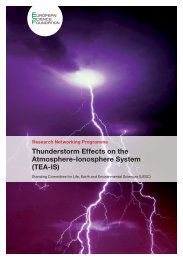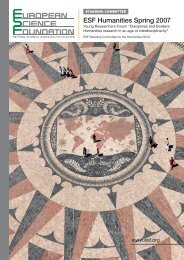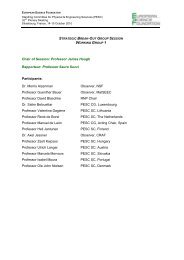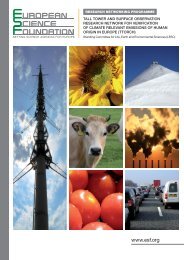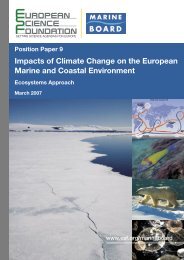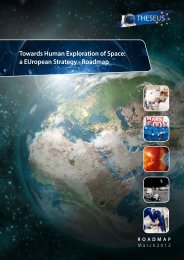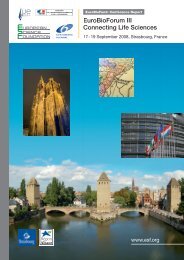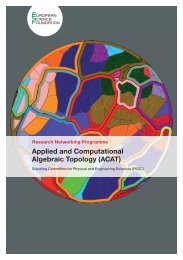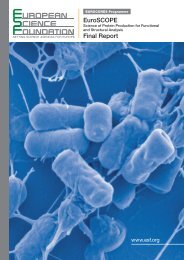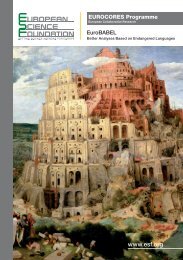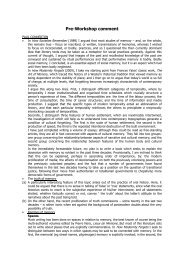Synthesis Report - European Science Foundation
Synthesis Report - European Science Foundation
Synthesis Report - European Science Foundation
Create successful ePaper yourself
Turn your PDF publications into a flip-book with our unique Google optimized e-Paper software.
27Figure 6. The vision of an open knowledge system (right-hand side) compared to the current practice (left-hand side) (After Tàbara, 2005).The two illustrations in Figure 6 represent in asimplified way the current knowledge system anda vision of an open system. On the left-hand side,all different types of knowledge (e.g., scientificknowledge from different disciplines and knowledgeof stakeholders) are assumed to be the same.It also assumes that the progress of knowledge islike a filling a glass of water – once the glass is fulleverything is known. On the right-hand side, differentclusters of largely indivisible and irreduciblenature-knowledge-practices emerge from long-term,social-ecological systems learning and evolution.These clusters represent processes in which a particularproblem (e.g., energy supply in a village, waterquality in a watershed, climate change impacts ina mountain region, mobility in an urban area, etc.)is discussed among a range of stakeholders, all ofwhom bring their different kinds of knowledge intothe process. The knowledge is integrated in order toreach a common understanding of what the problemreally is and which underlying drivers need to betackled. The process can then evolve to again integrateknowledge in finding and testing solutionsto the problem and learning about what works andwhat does not work. New findings give rise to newquestions, new sources and forms of knowledge thatneed to be addressed and integrated. Integrationthus can be improved to address certain questions,problems as well as potential solutions, many ofthese are overlooked under the current way of inte-gration (i.e., left-hand side of Figure 6) because whatis integrated on the right-hand side are contextualsources of knowledge, as well as different ways offraming problems, rules of organisation and possiblesolutions which may or may not be useable inother contexts.Likewise, the arrow on the left-hand side representsthe idea, widely embedded in the academic worldtoday, that the advance of knowledge requires itstranslation into a single way of representation.As discussed in the section above on the need fortransdisciplinarity, the arrow on the left-hand siderepresents the mode of ‘science finds the answersand tells the others what to do’, whereas on the righthandside, science is integrated in each cluster andprovides one of the sources of knowledge needed todescribe the problem and find the solution.A radically interdisciplinary andtransdisciplinary environmentWithin the vision of an open knowledge system,RESCUE Collaboration emphasises the design andfunding of a Radically Inter- and Transdisciplinaryresearch Environment (RITE). Each of the clustersin Figure 6 has to be both interdisciplinary andtransdisciplinary (see definitions in Annex 3). Inaddition, the shaded part on the left-hand side ofthe open knowledge system requires interdiscipli-Responses to Environmental and Societal Challenges for our Unstable Earth (RESCUE)



